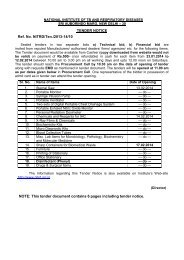October - LRS Institute of Tuberculosis & Respiratory Diseases
October - LRS Institute of Tuberculosis & Respiratory Diseases
October - LRS Institute of Tuberculosis & Respiratory Diseases
You also want an ePaper? Increase the reach of your titles
YUMPU automatically turns print PDFs into web optimized ePapers that Google loves.
ADULT RESPIRATORY DISTRESS SYNDROME<br />
Thus, the patient is worse than before<br />
though arterial Pa02 is high. The smaller the<br />
a/A ratio, the worse is the patient’s gas status,<br />
reflecting a poor overall oxygen transfer between<br />
alveoli and blood.<br />
11. Hemodynamic monitoring : The decision<br />
between cardiogenic and noncardiogenic pulmonary<br />
edema and hemodynamic situations are<br />
best decided by the use <strong>of</strong> flow-directed Swan-<br />
Ganz catheter. A pulmonary capillary wedgepressure<br />
<strong>of</strong> less than 15 mmHg indicates<br />
noncardiogenic origin and wedgepressures <strong>of</strong><br />
less than 5 mmHg indicate that the patient is<br />
hypovolemic/hypotensive. The cardiac-output<br />
can also be measured as it is equal to the<br />
oxygen consumption divided by the arterial<br />
content minus the mixed venous content for<br />
oxygen.<br />
Cardiac out-put= 02 consumption (ml/min)<br />
arterial 02 content - venous<br />
02 content (ml/100)<br />
Oxygen content is proportional to the<br />
amount <strong>of</strong> hemoglobin in grams/100 ml <strong>of</strong> blood<br />
multiplied by the oxygen saturation <strong>of</strong> the<br />
hemoglobin in percent i.e.<br />
Oxygen content=Hgb x Hgb saturation.<br />
The oxygen dissociation is a sigmoid shaped<br />
curve and indicates that the Pa02 in excess <strong>of</strong><br />
85 mmHg adds little additional oxygen to the<br />
blood while a fall below 50 mmHg leads to large<br />
reduction in oxygen content.<br />
The trend <strong>of</strong> cardiac output can be assessed<br />
by estimating mixed venous oxygen tension<br />
(PV02). If the arterial P02 is relatively constant,<br />
a decrease in the PV02 implies that the cardiac<br />
output has fallen and tissue perfusion being<br />
inadequate, more oxygen per unit time has been<br />
extracted from the blood. When PV02 is less<br />
than 25-30 mmHg, it indicates tissue<br />
oxygenation problems.<br />
Complications<br />
Multi-organ failure and ventilatory and<br />
Intensive care setting in the management <strong>of</strong><br />
ARDS can lead to many complications (Pingleton,<br />
1982). Pulmonary complications include<br />
pulmonary embolic disease which is difficult to<br />
diagnose without a pulmonary angiogram (Table<br />
IV). Prophylactic low-dose heparin decreases the<br />
incidence <strong>of</strong> pulmonary emboli (Pingleton et al,<br />
1981). Pulmonary barotrauma includes<br />
pneumothorax, pneumomediastinum and<br />
subcutaneous emphysema. High inflation<br />
163<br />
pressures during the use <strong>of</strong> volume ventilators,<br />
high levels <strong>of</strong> PEEP, high tidal volumes,<br />
necrotizing pneumonias and bronchoscopy<br />
during mechanical ventilation may lead to<br />
ba.rotrauma (Bone et al, 1976).<br />
Gastrointestinal hemorrhage, a fatal complication<br />
can be averted by the prophylactic use<br />
<strong>of</strong> antacids (Kahn et al, 1981). Cardiac<br />
complications include arrhythmim, hypotension<br />
and low cardiac output. Although use <strong>of</strong> flowdirected<br />
balloon-tipped Swan-Ganz catheters<br />
can monitor these complications but it may<br />
itself be arrhythmogenic. Renal failure and<br />
nosocomial infection may be associated with<br />
increased mortality in ARDS.<br />
Anticipation <strong>of</strong> complications, use <strong>of</strong> prophylactic<br />
measures and intensive management<br />
is vital for patient management.<br />
Prognosis<br />
ARDS carries a mortality in excess <strong>of</strong> 50 and<br />
it has not changed much in the last decade in<br />
spite <strong>of</strong> important developments in intensive<br />
care monitoring and organ support devices. The<br />
prognosis, however, depends upon the<br />
effectiveness dcause, <strong>of</strong> therapy, <strong>of</strong> syndrome, or<br />
t<br />
py and the p<br />
absence <strong>of</strong> complications and unrelated<br />
diseases. Once the patient with ARDS survives<br />
pulmonary function may return to near normal<br />
in 85 % <strong>of</strong> patients. Residual sequelae (diffusion<br />
b liti i fl b t ti ) t d t<br />
Future<br />
Cyclo-oxygenase blockers, antioxidants (superoxide<br />
dismutase, Vit. E) prostaglandin<br />
inhibitors (indomethacin, ibuprotein), prostacy<br />
clinin fission etc. and similar compounds are<br />
some <strong>of</strong> the current approaches under test.<br />
Monoclonal antibody technology may be used to<br />
prevent neutrophilic aggregation in response to<br />
C5a and other chemoattractants. Artificial<br />
surfactant might be delivered by inhalation or<br />
intrevenously as lipsomes.<br />
There is also a need to find a marker for<br />
ARDS to help identify patients likely to develop<br />
ARDS-D-Dimer, a fibrin degradation product is<br />
one such possible marker. Evidence <strong>of</strong><br />
complement activation may also serve as a<br />
marker. As life-support systems alone cannot<br />
stem the death-toll, innovative pharmacologic<br />
approaches must be tested, including possibly<br />
multidrug regimens each aimed at a specific<br />
pathophysiologic process known to be operating<br />
in these patients.
















